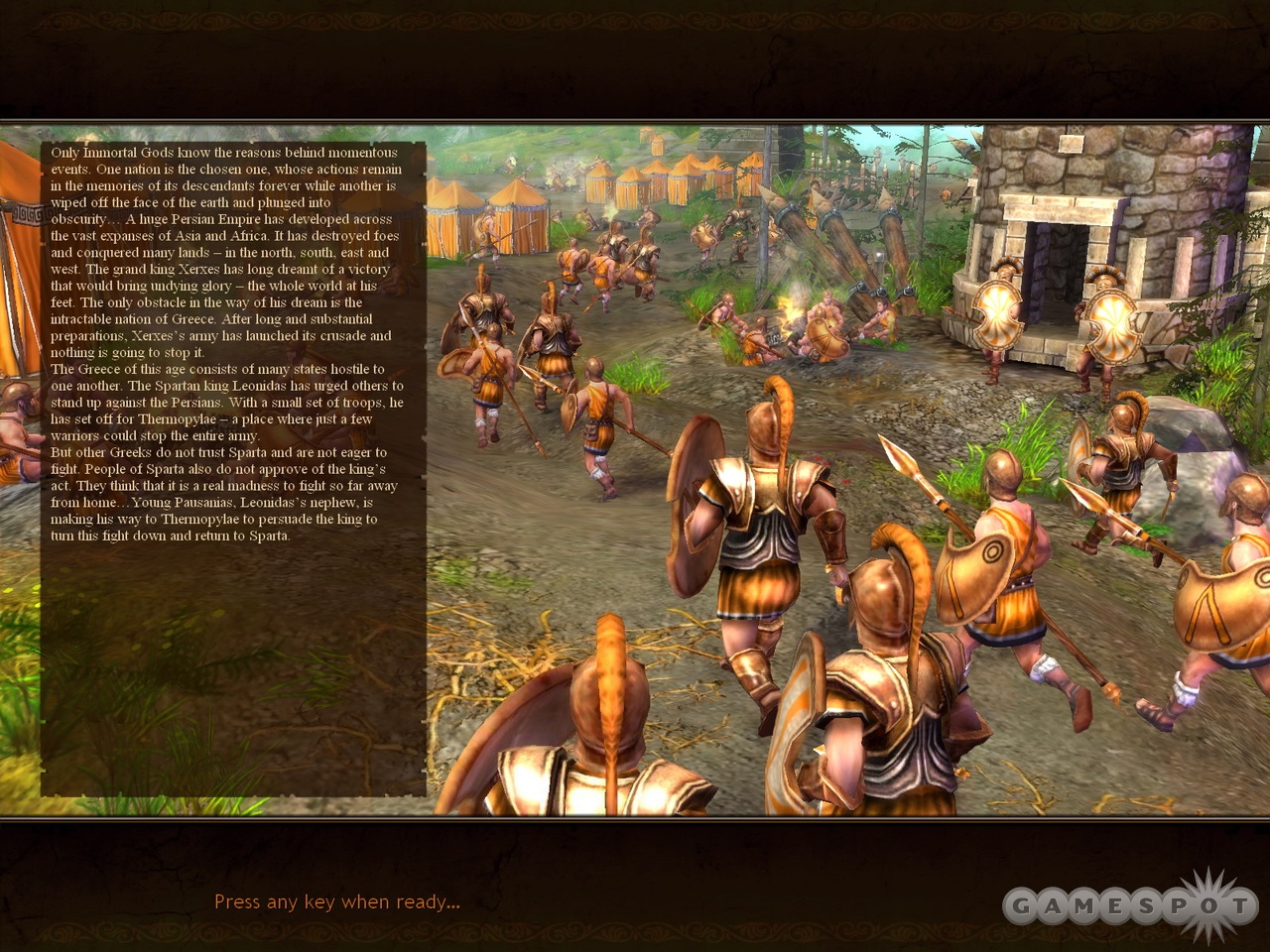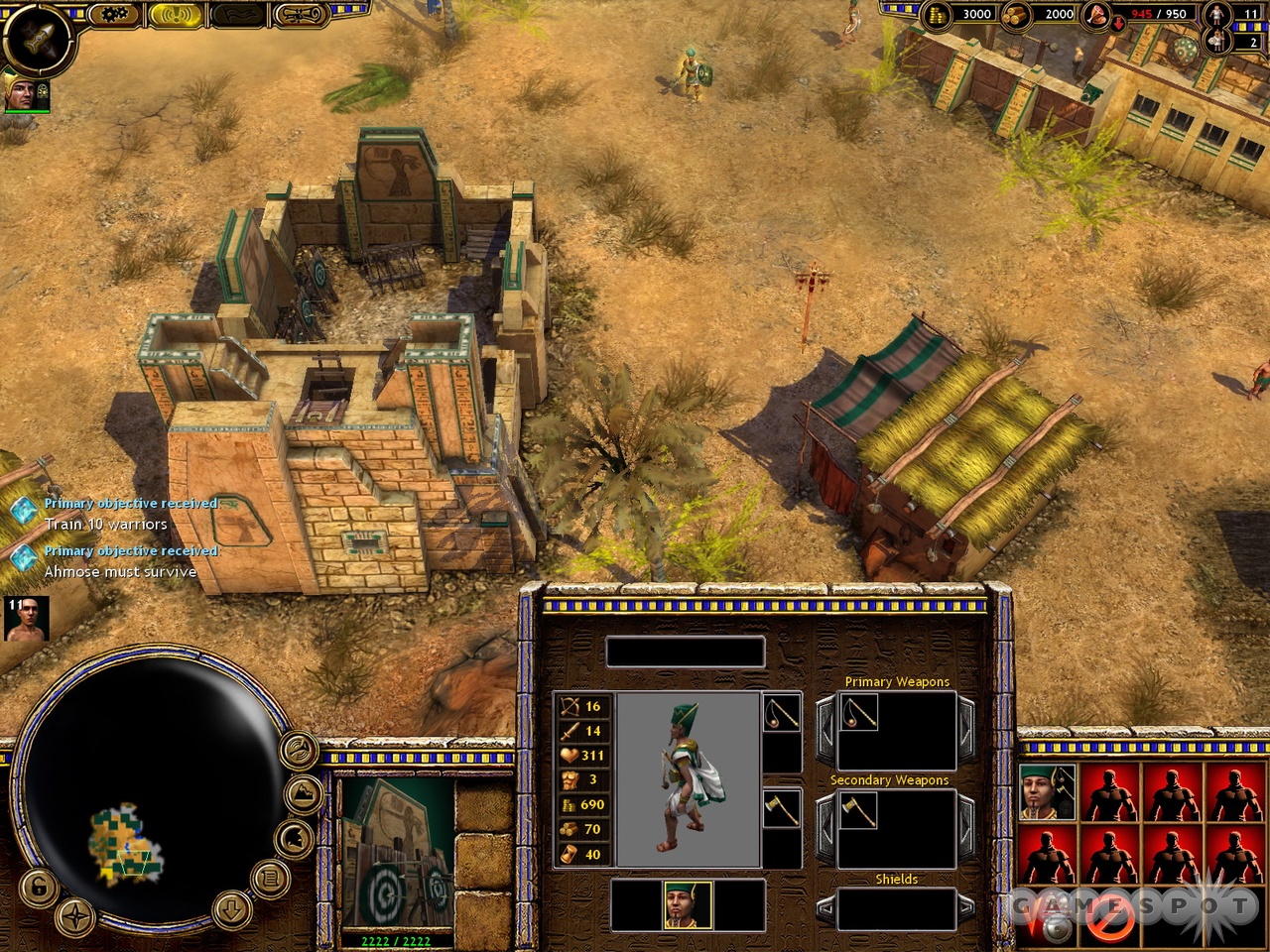Ancient Wars: Sparta Final Hands-on
World Forge's real-time strategy game is nearing completion, and we take a look at how it's shaping up ahead of its April release.
Initially set for a fourth-quarter 2006 release, Ancient Wars: Sparta was pushed back to April 2007 to give Russian developer World Forge more time to polish the code. When we first saw the game back in September 2006, it showed some promise. Recently, we dove straight into the game when given the chance to revisit it.

The game is set in ancient Greece and the surrounding area and features three factions: Spartans, Persians, and Egyptians. Each faction has its own unique story campaign, which builds in size and complexity as you go. Some missions require you to complete them with the units you're given at the beginning of the game, but most missions require you to act in the more traditional resource-building fashion, giving you a base from which to develop and build your forces.
Right off the bat, the game feels a lot like the classic RTS game Age of Empires II: Age of Kings, but with a significant graphical overhaul. It's the kind of game that encourages you to build up your stash of supplies and take on the various challenges around the map piecemeal, gradually increasing your army's strength and taking over vital resources as you go. In general, the missions task you with either locating key heroes or destroying opposing armies and bases, while the story for each faction unfolds in cutscenes along the way.
The Spartan campaign is based on the imminent Persian invasion of Greece and the disagreements that the various Greek factions have about whether to resist or not. The Spartan king, Leonidas, is keen to move quickly to Thermopylae, a defensible position at which it would be possible to hold the Persian army off for some time. But not everybody is of the same opinion, which means you'll need to guide Leonidas and his army against a variety of enemies before you're done.
The Persian campaign lets you see things from the opposite side, playing as Xerxes, starting out just as he's taken the throne. The main thrust of this campaign lies in organising the war against Sparta, with the help of the former Spartan king, Demeratus, although there's also unrest to deal with at home.
The Egyptian story is further removed from the first two, with the country having been enslaved for many decades by the Persians. This story follows Inaros, a dutiful Egyptian warrior pushed too far by the oppressive new governor, who steals away his true love.

All three campaigns have reasonable depth to them, with about 30 hours of gameplay estimated for the three campaigns combined. It's also possible to play competitive multiplayer online or via a LAN connection, with various maps and all three races playable.
In terms of the action itself, the game boils down to the art of balancing resource management with heading off enemy activity. As with most games of this kind, the computer artificial intelligence will build offensive units and send them your way until you're in a position not just to fend them off, but to send an attacking party their way.
However, the battle-ready units are just half of your concern because you'll need to assign workers to gather gold, wood, and food from various sources. There are also typical upgrade buildings, which allow you to research and improve your existing choice of weaponry and armour, as well as defensive structures and storage facilities.
It's also possible to send your workers out to gather weapons and armour from the field of battle, which can then be used to kit out your own troops. This leads nicely on to one of the more refreshing aspects of the game--your army designer. This is a tool within the melee or ranged unit production buildings that allows you to decide what your troops will carry or wear.
To begin with, your options are limited, but as you research further into the tech tree, you'll open up stronger items. Of course, the better the item, the more gold or wood it costs to produce per unit, unless you've scavenged enough from fallen soldiers, in which case it'll be cheaper. Over time, you'll be able to build a number of different unit configurations for use in varying situations, which is something we think will come into its own in the multiplayer arena.
For example, you'll be able to decide whether you want to focus on large numbers of cheap, less powerful troops, a handful of elite soldiers, or a blend of the two. As your building options become more complex, you'll also factor ships and siege weaponry into your tactical options. Each faction has some unique troop options available, but overall, they balance out in a kind of rock-paper-scissors way.

World Forge has tried to implement a physics simulation into the game to make it more satisfying. This manifests itself in various ways, from boulder traps that roll down hillsides to speeding chariots that send warriors on foot flying through the air.
There are still a couple of issues in the build we played that could take the gloss off the game for some users. Firstly, the sea battles, which have enormous potential, feel a little underdeveloped at this point. Despite the fact that it's possible to grapple other ships and potentially take them over, most sea battles end up being ponderous affairs that don't seem to match the pace of the rest of the game.
There are also some pathfinding and target-selection problems, which we're hoping will be tightened up for the final release. For example, sometimes your troops will take odd routes to objective points and encounter considerable problems if gates are involved. In the heat of battle, while your soldiers do a decent job of engaging the enemy, if you manually select targets, they'll often waste time running past opposing units before backtracking to actually start attacking. It's a minor point, but one that can make a difference when two sides are evenly matched.
The visuals are looking really nice at this point. Light sourcing leads to lovely reflections and shadows, especially in the water. Also, the detail level of the character models is good, and the environment can be viewed from any angle. It would have been nice to be able to zoom further out, because it feels like there's a lot of unnecessary scrolling right now, but that's a relatively minor point. The music and voice acting fit the part while the storylines progress at a good rate.
In all, it's clear that the game is nearly ready for release, and fans of classic RTS gameplay should find something to get stuck into here. Keep an eye out for our review in the next month or so.
Got a news tip or want to contact us directly? Email news@gamespot.com
Join the conversation